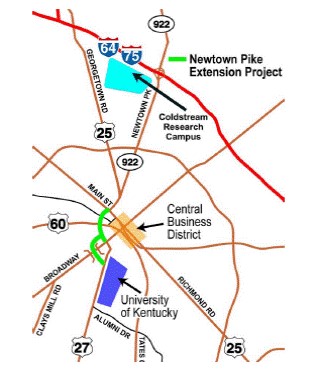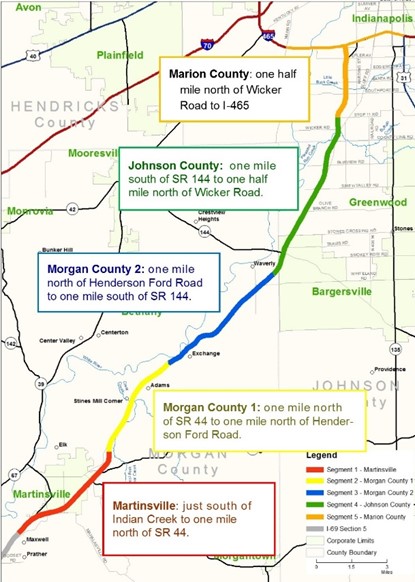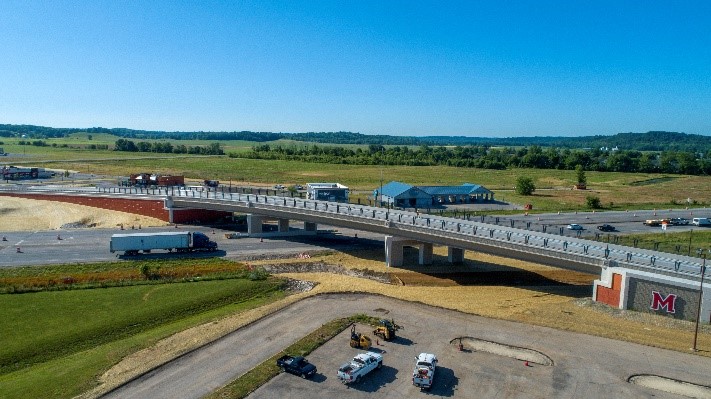
Incorporating Environmental Justice into Highway Projects
What Is Environmental Justice?
Environmental justice (EJ) at the Federal Highway Administration (FHWA) means addressing disproportionately high and adverse effects of the agency’s programs, policies, and activities on minority populations and low-income populations to achieve an equitable distribution of benefits and burdens.
EJ at FHWA is informed by the following legislation, regulations, and guidance:
This issue of Successes in Stewardship focuses on environmental justice (EJ) and how the Federal Highway Administration (FHWA) and State agencies work to prioritize EJ in major transportation construction projects. EJ helps to ensure full and fair participation by potentially affected communities in every phase of the transportation decision-making process. In the two project highlights below, EJ was successfully incorporated in different ways.
In 1994, President Clinton signed Executive Order (EO) 12898: Federal Actions to Address Environmental Justice in Minority and Low-Income Populations. This EO directs Federal agencies to take the appropriate and necessary steps to identify and address disproportionately high and adverse human health or environmental effects of Federal programs, policies, and activities on minority populations and low-income populations to the greatest extent practicable and permitted by law. In addition to adhering to EO 12898, Federal-aid transportation projects must follow DOT Order 5610.2C: Actions to Address Environmental Justice in Minority Populations and Low-Income Populations, to consider EJ principles throughout planning and decision-making processes by:
- Including explicit consideration of potentially disproportionately high and adverse effects on minority populations and low-income populations;
- Avoiding imposing adverse effects on minority and low-income communities;
- Providing meaningful opportunities for public engagement with members of minority and low-income populations during planning and project development; and
- Providing the public, including EJ populations, access to public information concerning the human health or environmental impacts of activities that will address the concerns of EJ populations regarding the health and environmental impacts of proposed access in languages other than English and in accessible formats for persons with disabilities.
In 2012, FHWA also issued EJ Order 6640.23A, which provides a framework to identify and prevent discriminatory effects when administering FHWA’s programs, policies, and activities.
In addition, the National Environmental Policy Act (NEPA) requires that Federal agencies consider the social and environmental effects of projects proposed for Federal funding. Recipients of FHWA funds must determine if an EJ population will be impacted by a project, and if so, document whether the impact will have a disproportionately high and adverse effect.
Project Highlight: Newtown Pike Extension
Newtown Pike Guiding Principles
- Reduce traffic congestion both in the downtown and in neighborhoods within the project corridor by providing alternative routes and lessening traffic diverging through neighborhoods;
- Improve pedestrian safety downtown, along neighborhood streets and on the north end of the University of Kentucky campus;
- Encourage greater use of alternative modes of transportation by providing an increase in infrastructure that supports walking, cycling, and public transit;
- Recognize the potential impacts of the proposed Newtown Pike Extension on the surrounding communities through the use of extensive public involvement;
- Mitigate the proposed project impacts through implementation of Lexington Fayette Urban County Government’s Small Area Plans;
- Cooperate and commit to actions that address the transportation needs, environmental justice issues, and affordable housing within the low-income neighborhoods of Davistown, Irishtown, and Pralltown while providing compatible development and cultural/aesthetic enhancements;
- Provide an opportunity for redefining and improving the attractiveness of the downtown; and
- Accomplish the above without imposing an unfair burden on other areas.
Newtown Pike in Lexington, Kentucky, connects I-64/75 with the University of Kentucky (UK), Lexington’s hospitals, and shopping districts. Prior to the construction of this project, a trip from one side of the city to the other required traveling through Lexington’s central business district, causing significant congestion in downtown Lexington. City leaders recognized the need for a downtown bypass beginning in the 1930s. In the 1970s, plans for an interstate spur were abandoned due to community opposition. By the 1990s, Newtown Pike was a multi-lane roadway connecting I-64/75 with the city center. It stopped short of completing the bypass route, ending at a neighborhood known as Davistown.
The Newtown Pike Extension Project sought to complete the bypass to reduce traffic congestion, improve traffic flow through downtown Lexington, provide more efficient routing to the University of Kentucky (UK), and improve pedestrian and bicycle accessibility and safety—all without causing a burden to neighboring communities. A multi-agency Stakeholders’ Committee formed to determine how to reactivate the project in 1998. The project’s record of decision was issued in 2007, and the project was constructed from 2007-2014. Many case studies have been written about Newtown Pike, but this article aims to shed light on the project team’s early commitment to EJ, and how a set of guiding principles influenced project development.
The Kentucky Transportation Cabinet (KYTC), in cooperation with the FHWA Kentucky Division, conducted a community impact assessment and socioeconomic evaluations prior to developing the environmental impact statement for the project. In doing so, they determined that the project would have disproportionately high and adverse impacts on the Davistown neighborhood.
Davistown is a low-income and minority neighborhood with a rich history dating to the 19th century; it is a close-knit community home to multiple generations of families. For years, residents had anticipated the Newtown Pike Extension and feared its potential effects on their community. Initial project plans would have divided their neighborhood, displaced most residents through relocations, and increased the land value in surrounding communities, forcing out low-income residents. Because of the decades-old discussions surrounding the project, there was a sense of concern, skepticism, and distrust in government at the outset of the project.
To address the project’s potential impacts and enhance quality of life, a local, State, and Federal agency partnership was formed, consisting of FHWA, KYTC, Lexington Fayette Urban County Government, and UK. The team developed a document containing a set of guiding principles, which they signed in August 2002, to ensure a commitment to minimizing the adverse impacts and improving the quality of life for the Davistown community at every stage of project development.
These principles served as the foundation that guided major project decisions. The project team foresaw that right-of-way acquisition and other complicating factors would lead to a years-long process. Developing a written consensus on guiding principles at the beginning ensured that the agencies’ intentions would not be lost or forgotten in logistical details and personnel changes.

Figure 1. Map showing the location of the Newtown Pike Extension project. Source: FHWA.
Thanks to the guiding principles, the project team achieved stakeholder buy-in on a number of unprecedented mitigation efforts to benefit Davistown residents. Informed by the principle of extensive public involvement, the project team invested in a wide variety of approaches that allowed the team to engage individually with each resident. The project team hired a community liaison and two social workers as part of the mitigation efforts to help the surrounding community understand how the project would affect them and to identify and address residents’ concerns. Furthermore, UK provided an anthropologist to conduct a rapid assessment survey of the community’s social ties. The project team understood that establishing trust among residents would require face-to-face, two-way communication, and knew that hiring a liaison, social workers, and an anthropologist could facilitate this process. Project leaders recalled that the outcomes of these meetings were a turning point for the project, as it humanized the project’s impact from their perspective and motivated them to think creatively about mitigation options.
The project team also established a Community Land Trust (CLT) called Davis Park to provide sustainable and long-term affordable housing for the community, in accordance with the sixth guiding principle. During the development of Davis Park, the project team upheld the principle of mitigating the project’s impact by providing displaced residents the option to relocate to temporary homes in the neighborhood. They provided the temporary housing facilities in a former baseball field where residents could live rent and utility free. The first phase of Davis Park was completed in 2014, and since then additional permanent housing units have been developed in the urban village. The charter of the CLT reflects the principles as well: to ensure that displaced residents benefited from the new housing, the CLT was only open to Davistown residents for the first five years of its existence. Now, the CLT is open to others, and it is allowed to acquire new land and provide affordable housing in other neighborhoods of Lexington.
From the very start of the Newtown Pike Extension project, the guiding principles served as a conscience anchoring every decision in the project delivery process. When the project team encountered conflicts among themselves, the guiding principles allowed them to focus on their shared vision and goals. The principles also challenged them to think creatively, beyond mitigation options already in standard practice, to meet the unique needs of displaced residents. In the end, the team’s early commitment to EJ through the guiding principles document led to a successful project that made good on its promise of addressing the long-term needs of Davistown residents.
Project Highlight: I-69 – Indiana DOT
Indiana DOT’s (INDOT) I-69 project also offers practitioners some notable practices for incorporating input from EJ outreach efforts in decision-making. The sixth and final section of I-69 in Indiana will add more than 26 miles of new interstate highway, stretching from Martinsville to Indianapolis. The larger I-69 corridor encompasses 142 miles, connecting Evansville to Indianapolis. The goal of the project is to strengthen southwest Indiana’s transportation network, spur economic development in the region, and complete Indiana’s portion of the national I-69 route. Environmental review for the project was initiated in 1999, and in 2004 FHWA selected an alternative and divided the 142-mile corridor into six sections. Sections 1 through 5 are now complete and open to traffic. For these sections, INDOT did not identify EJ populations that would be adversely impacted by the project. However, for Section 6, INDOT decided to modify their outreach to EJ populations through an extensive targeted public involvement strategy.
Section 6 will construct 26 miles of interstate in metropolitan Indianapolis and areas south. Construction on Section 6 began in 2019, and it is expected to open to traffic in late 2024. INDOT identified several low-income, majority white populations living in Martinsville, a rural community on the outskirts of the urban area at the southern terminus of Section 6; several low-income areas in the middle and northern portions of the corridor; and an area with a large Burmese population. At the beginning of the project, INDOT established an EJ subcommittee to disseminate information and gather comments and concerns from EJ communities. Through the subcommittee, EJ worked with FHWA and the community to identify where the EJ populations were located and to develop ways to communicate with them about project updates.

Figure 2. Map showing the location of the I-69 Section 6 project. Source: INDOT.
To establish a mutual line of communication, INDOT hosted five community meetings where they distributed surveys (in English and Burmese), provided community project updates, addressed concerns, and answered questions. INDOT categorized surveys results to help identify the concerns and inform the appropriate project design refinements. The project team hosted multiple meetings at easily accessible locations. Holding the meetings on different days and times of the week allowed residents with various work schedules to attend. To reach residents who were unable to attend in-person meetings, INDOT conducted additional outreach including residential surveys, neighborhood gatherings, and social media outreach on Facebook and Twitter. Additionally, INDOT established two community advisory committees, consisting of school superintendents, mayors, town managers, city and county planners, fire chiefs, transportation directors, and representatives from the Chamber of Commerce, which represented the northern and southern areas of the project. INDOT met with these groups on a quarterly basis to share project updates and get feedback from the members. The advisory committee meetings helped INDOT to understand community life in the project areas, to help determine where to hold meetings and how best to reach out to EJ communities.
One of the main concerns from the communities focused on community cohesion, particularly regarding long-term pedestrian access across the interstate for traveling to work, hospitals, churches, and commercial businesses. Before construction began, pedestrians crossed the State highway despite it being a vehicle-only crossover point. The project team took note of this, added safety signage to discourage unsafe pedestrian crossing during construction, and incorporated safe, legal pedestrian facilities over I-69 to provide long-term pedestrian connectivity. Furthermore, at each community meeting, INDOT provided project updates and a map of pedestrian connections and vehicle crossover points. Based on community feedback, INDOT invested in more cross-connectivity than initially planned. INDOT ensured there were enough over/underpass locations to improve connectivity throughout the construction process and beyond. To enhance the safety of pedestrians and bicyclists, INDOT added sidewalks to the new bridge and a single lane of traffic in each direction to accommodate motorists and bicycles.

Figure 3. Grand Valley Boulevard Bridge in Martinsville, Indiana. Source: INDOT.
As a result of feedback gathered during extensive outreach efforts, INDOT modified the project to significantly reduce and in many cases eliminate direct impacts to EJ populations, including residential and commercial relocations. In the final environmental impact statement, INDOT estimated that the project would result in 187-561 relocations in block groups with minority and/or low-income populations, including relocating an entire mobile home park. INDOT refined the design to minimize those impacts, resulting in a decrease to 30 relocations in EJ communities. When completed, the project will provide additional benefits to the community beyond the new transportation options provided by the interstate. INDOT worked with communities along Section 6 of the corridor on context-sensitive design solutions. For constructing bridges, the team incorporated context-based concept designs such as gateways to the communities.
Since construction has begun, INDOT continues to engage residents using proactive public involvement approaches to ensure they are aware of road closures and project updates. The I-69 Finish Line, the project’s new name, has a website and Facebook page to keep the community notified of major construction updates and upcoming public information meetings. INDOT has a project office available to the community Monday through Friday, which is located in the middle of the 26-mile project corridor. When the office is open, INDOT and consultant staff are available to answer any questions about the project and how it may affect the communities. Staff can also be available outside of business hours by request to accommodate residents’ work schedules.
This project is expected to reduce travel time by widening the highways and removing traffic stops. It will also improve safety through enhancements to existing highway infrastructure. Finally, it will maintain community connectivity through bicycle and pedestrian connections and the addition of 14 new overpasses and underpasses and 39 new bridges. Construction for Section 6 is expected to be completed by 2024.
Robust public involvement was a major success factor in this project, which highlights the importance of public involvement to address EJ communities’ concerns and needs. Sections 1-5 of this project were planned and constructed over the course of 14 years, the metro Indianapolis communities anticipated the project without understanding when and how exactly they would be affected by the project in their area. Once INDOT identified the EJ populations that may face potential impacts by Section 6, they listened to the community’s fears and made the necessary adjustments to help mitigate them. By hosting public meetings, distributing surveys, and encouraging involvement from local officials, INDOT was able to receive critical community feedback to inform project adjustments that significantly reduced direct impacts to the low-income, rural population.
For More Information
To learn more about the Newton Pike Extension project, see the following resources:
To learn more about the I-69 Finish Line, see the following resources:
FHWA has developed several EJ resources for practitioners:
- The National Highway Institute’s web-based Fundamentals of Environmental Justice training.
- The EJ reference guide helps FHWA staff and practitioners build capacity and knowledge on EJ. The guide provides background on EJ, presents techniques for integrating EJ into overarching activities, relates EJ principles to the phases of transportation project development, and discusses public involvement. The reference guide discusses key questions related to EJ in environmental review. It also discusses the role of FHWA Division Offices and recipients of FHWA funds in integrating EJ into FHWA-activities, including NEPA documentation.
- FHWA’s EJ resource center links to resource guides called the Transportation and Environmental Justice Effective Practices. The Effective Practices provide practical examples relevant to an array of practitioners on how environmental justice has been integrated into transportation programs, policies, plans, and activities.
- Additional EJ and NEPA case studies focus on EJ analysis during the environmental review process.
Contact Information
Bob Washington
Environmental Protection Specialist
Office of Project Development & Environmental Review
202-366-4651
robert.washington@dot.gov
Megan Cogburn
Environmental Protection Specialist
Office of Project Development & Environmental Review
202-366-2056
megan.cogburn@dot.gov
Audra Bandy
Environmental Protection Specialist
Office of Project Development & Environmental Review
202-366-2034
audra.bandy@dot.gov
John Foley
Environmental Protection Specialist
Office of Project Development & Environmental Review
202-366-0524
john.foley@dot.gov
Look What’s New!
- Environmental Justice Analysis in Transportation Planning and Programming, State of the Practice is available on this webpage.
- Addressing Changing Demographics in Environmental Justice Analysis, State of the Practice is available on this webpage.
- NHI Course 142075, Environmental Justice Analysis is available in the NHI course catalog.
Successes in Stewardship is a Federal Highway Administration newsletter highlighting current environmental topics, with an emphasis in accelerated project delivery and stewardship practices from around the country. Click here to subscribe, or call (617) 494-2129 for more information.

